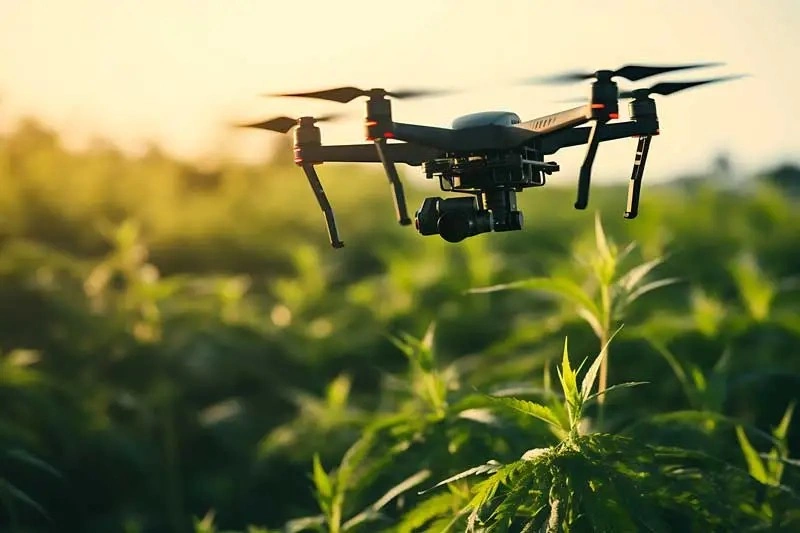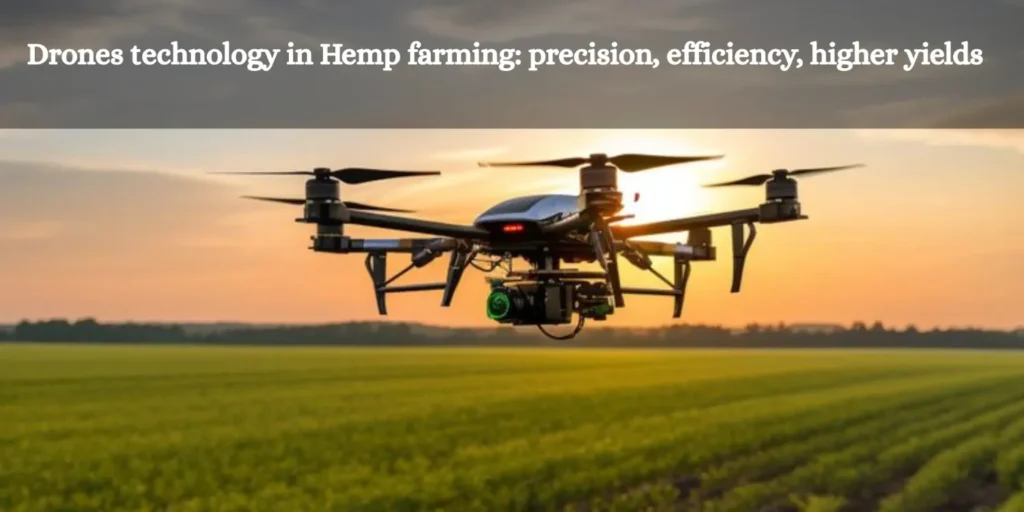Managing huge farms with great precision requires the implementation of advanced use of drones technology, including robots. Hemp cultivators use drones technology to improve and initiate accuracy in their hemp farming. It is used to enhance agricultural mechanisms. Industrial hemp is known for its wide popularity and for its diversity and sustainability, which is vital for the agricultural economy.
DRONES TECHNOLOGY in Hemp Farming

The global hemp industry, driven by the enhanced role of CBD, textiles, and bio-fuels, hempcrete is rapidly expanding at a faster pace. Hemp cultivation faces unique challenges of nutrient management, pest outbreaks, and is circumscribed by difficult regulations.
Conventional farming method leads to uneven or manual spraying or tractor-mounted systems, leading to uneven distribution, environmental harm. Whereas hemp farming drones emerge as a transformative solution. Which also includes AI-driven precision, real-time data analysis to optimize, crop protection, while meeting the demand for an ever-growing population.
Drones are efficient tools for farmers using AI-generated mechanisms using drone technologies makes sense.
1. Crop Inspection
This instills the command in drones to look after the field/plot of land to survey the topography, and measure the soil health and type, which gives GPS coordinates and signals the farmers. Gives these features, one can visit many in a dayywhich is tech-driven.
2. Monitoring the terrain
Drones allow farmers to technically and mechanically visit their land and to monitor every corner of their land minutely in an efficient manner, which is software software-generated mechanism.
The drone supervision can alert the farmers about climate change, topographic conditions, and diagnose the soil type of each section of the farm, and warn about any problem, such as areas prone to erosion. Having a better knowledge before the occurrence can help to mitigate the challenges.
And can give accurate decisions about how to sow the hemp seeds to make mindful decisions regarding the cultivation process.
3. Crop rotation mechanism
To keep soil intact, farmers often rotate crops few crops deplete the soil of essential nutrients like nitrogen and magnesium. By the process of rotation of the crop to replenish the soil, farmers keep the soil at an optimum level without the utilization of chemicals.
Items made from hemp are highly biodegradable, and hemp even deals with climate change through the process of carbon sequestration. The emergence of hemp lies in the fact that at one season the farmers can plant hemp for textile while at another they can plant for CBD, serving both the industries, keeping the soil type intact.
4. Spraying of fertilizers and pesticides
Hemp is hard and self-reliant, grows high and thick enough to cut out the weeds. It is having replacing properties with cotton, soybeans, and corn. Industrial hemp is a highly sustainable crop that is used to produce consumer products.
You Can Read Also: The surprising environmental benefits of hemp vs cotton
PRECISION AGRICULTURE IN HEMP CULTIVATION
Precision agriculture is also known as satellite farming. It is conceptualization as farming management, which relies upon observing, measuring responding to crop variability.
It makes the farming practices more accurate and controlled. It aims at enhancing farming practices, making it more accurate and controlled, and it aims to enhance farming efficiency to obtain maximum yield with limited available resources.
How does this precision farming work?
The sensors located in the field measure the moisture content in the soil. These satellite and robotic drones record pictures of the hemp plant, which is processed by specialized software.
They work in conjunction with sensors and other data obtained from the sensors of the unmanned machinery to gather guidance for the development of crop farming to estimate the irrigation areas. Integration of these in the farming practices can enhance accountability, and reasonable practice helps to preserve resources and reduce waste.
The cloud mechanism would store all such data and produce information in the form of graphs, charts, and alerts for precision in agriculture.
In the respect of cannabis sativa, which has been cultivated from time immemorial, the use of cannabis sativa varies depending on time and place, ranging from fiber, medicinal usage, to recreational uses.
There is are extensive number of chemicals present in the cannabis sativa, which ranges from THC/ CBD cannabinoid content and composition, which vary highly among cannabis strains. Hemp is unique in the sense that it integrates both the conventional agricultural method as well as precise science from the cannabis industry.
Growing hemp for CBD oil may be more complex than growing hemp for textiles.
CROP MONITORING DURING HEMP CULTIVATION
The research at the University of Florida Institute of Food & Agriculture Science has designed a method to monitor hemp crops from the air, equipping drones with installed cameras and supported by AI.
The drones work as an automated machinery, delivering high-speed supervision and monitoring the hemp crops from high altitudes. Its precision suits the hemp crop as they have tall heights, making it easier for drones to keep a watchful eye.
INITIATING SMART FARMING IN HEMP REGION
Hemp is one of the sought-after commodities around the world, known as marijuana as well in different parts of the globe. Smart farming is an end–to–end close monitoring of the hemp cultivation, enabling the field farmers to schedule, implement, and monitor farm practices to make sure that the farm practices are in agreement with the regulations.
Smart farming in hemp reduces wastage, develops productivity, and enables management of greater resources. Smart farming may also be known by the name of precision farming.
It includes a wide range of technologies wide including remote sensing, robotics, and AI, to form an integrated crop production management system to enhance profit and keep environmental quality. Appropriate knowledge and capital are necessary for this innovation.
CONCLUSION
New and innovative farming technique requires more and more professional skills; a farmer is not only a person with a passion for agriculture, but they are a legal expert and an expert data analyst, and an an economist.
The hemp industry is proliferating and revolutionizing at a greater speed, and its efficient management is a prerequisite for doing hemp farming. Drones are being widely used in hemp farming in this modernized agricultural functionality. Cannabis farmers and entrepreneurs estimate how many drones they need for an area of land, how much they will cost, between $2000 to $35000 each.
Frequently Asked Question

